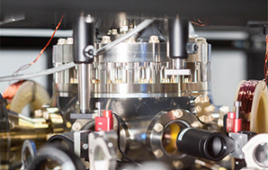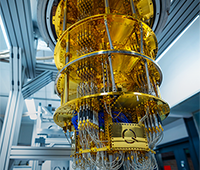Beyond: Visions of Our Solar System
 |
| Jupiter and Two of its Moons is on display at the Smithsonian National Air and Space Museum. A “fire and ice” pairing of Jupiter’s large moons — volcanic Io (lower left) and frozen Europa (upper right) — orbit across the face of the giant planet. Voyager 1, March 2, 1979 |
“Beyond: Visions of Our Solar System,” an exhibition of 148 brilliant color and black-and-white photographs — images from space captured by unmanned interplanetary probes — opened May 26 at the Smithsonian’s National Air and Space Museum. Artist Michael Benson combines art, science and photography in “Beyond,” which will be on view in the second-floor Art Gallery through May 2, 2011.
The exhibition is the result of Benson’s research in the archives of NASA, the European Space Agency and other sources of space photographs. The artist processed and combined the images to create large-format composite views of planets and moons. Photos in the exhibition cover objects from the entire solar system. The companion book to the exhibit, Beyond: Visions of the Interplanetary Probes was published by Abrams in 2003.
“As I researched the images taken by the Voyagers, the Vikings, Cassini and other interplanetary missions, I realized they belonged as much to art as to science; they constitute an important new chapter in the history of photography,” said Benson. “‘Beyond’ is among the most extensive exhibitions of planetary photography ever staged — with every planet and many of their moons represented — but individually, each image is extraordinarily unique. My hope is that visitors come away with a new awareness of how our Earth belongs to a vast continuity of related landscapes, all of them turning under the Sun. They will see that we are one world within a stunningly variegated archipelago.”
 |
| Erupting into Space: An 86-mile-high volcanic plume explodes above the horizon of Jupiter’s moon Io. The plume is erupting over a caldera (volcanic depression), named Pillan Patera, after a South American god of thunder, fire, and volcanoes. Galileo, June 28, 1997 |
Highlights include images of the eerie desert landscapes of Mars; photos of the frozen plains and spiraling ridges of Jupiter’s moon Europa; craters, volcanoes and lava flows on Venus; panoramic wide-screen views of Saturn and its rings; and images of the Earth and moon. Visitors can safely tour the intensely hot and strange topographies of the Venusian plains and a Martian canyon large enough to span the continental United States. Many of these pictures have never before been seen by the public, including striking new views from recent space missions.
The National Air and Space Museum building on the National Mall in Washington, D.C., is located at Sixth Street and Independence Avenue S.W. The museum’s Steven F. Udvar-Hazy Center is located in Chantilly, VA, near Washington Dulles International Airport. Both facilities are open daily from 10 a.m. until 5:30 p.m. Admission is free, but there is a $15 fee for parking at the Udvar-Hazy Center.



